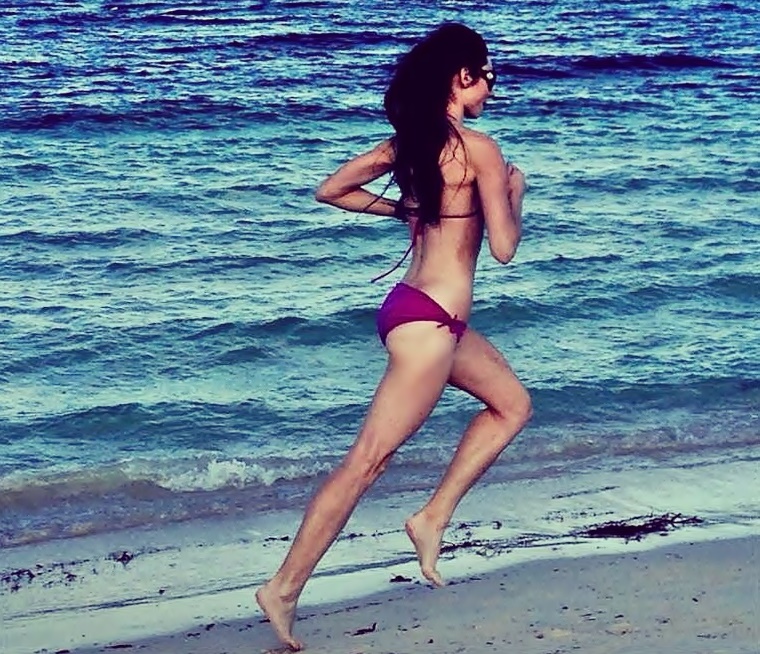My leg swing mechanics is different when I run barefoot vs when I run in shoes. When I run barefoot, I instantly notice that my feet rapidly pop up off the ground and come up higher towards my butt. This changes as soon as I run in shoes in that my foot removal seems slower, and my foot/ground reaction seems less responsive. To a new barefoot runner, the rapid foot removal may cause back of thigh pain.
Back of Thigh Pain From Barefoot Running
If you get back of thigh pain during or after barefoot running, don’t worry, there’s a good reason why this pain is there.
You have to remember that switching from years of running in shoes to abruptly running without shoes, requires a lot of neuromuscular adaptations, which includes changes in muscle activity, particularly in the thigh muscles because these muscles mediate how quickly the foot is pulled from the ground.
The main reason why the back of your thighs hurt when barefoot running is that the nerves in the sole of the feet are highly responsive to painful stimuli. These nerves also communicate to the spinal cord, which activate certain muscle groups in the thigh that allow for the pulling of the foot.
In the case of barefoot running, the hamstrings are more activated, so that the foot can be pulled up from the ground to avoid painful collision forces. Overall, withdrawing the foot from the ground occurs at a faster rate in barefoot running as compared with running in shoes — this is why the back of your thighs hurt after running barefoot for the first few times.
A study by Tam et al. (2016) discovered that shod runners, with no prior experience with barefoot running, had a greater activation in the posterior muscles of the biceps femoris (back of the thigh) when they ran barefoot as compared with shod runners, suggesting that new barefoot runners may experience localized pain in the back of thighs because the thigh muscles are being used in a new way, to pull the foot up quicker from the ground.
But why is foot removal reaction slowed when you run in shoes? Simply because the cushioned material of the shoe slows the withdrawal response by ‘de-activating’ the cutenuous receptors lining the bottom of the feet, causing the central nervous system to perceive the hard ground as feeling soft. Therefore, rapid foot withdrawal is less needed because running shoes makes the hard ground feel comfortable.
When running barefoot, the body must use a way to avoid injury and it does this by utilizing a forefoot strike landing and by using a more responsive, quicker removal of the foot via greater muscle activation of the thigh muscles. So, stop thinking of your thigh soreness as a negative reaction to barefoot running, rather, start thinking about it as neuromuscular adaptations that will soon lead to more strength gains. This pain is important because its indicating that your body is actually creating a safer landing environment during barefoot running.
One more thing: Don’t stretch your sore thighs because stretching is going to be minimal help for you in the long run as stretching has negative implications on performance and it may even worsen the pain.
More From Run Forefoot:
Best Barefoot Running Resources
Don’t Want to Go Barefoot? Here are Barefoot-Inspired Running Shoes
References:
Tam et al. Individual Responses to a Barefoot Running Program: Insight Into Risk of Injury. Am J Sports Med, 2016; 44(3): 776-784.
Bretta Riches
BSc Neurobiology; MSc Biomechanics candidate, ultra minimalist runner & founder of RunForefoot. I was a heel striker, always injured. I was inspired by the great Tirunesh Dibaba to try forefoot running. Now, I'm injury free. This is why I launched Run Forefoot, to advocate the health & performance benefits of forefoot running and to raise awareness on the dangers of heel striking, because the world needs to know.
Latest posts by Bretta Riches (see all)
- Cushioned Running Shoes Found to Be Bad for Ankles - 23/04/2024
- Forefoot Running and Achilles Pain - 19/04/2024
- Does Foot Strike Really Matter in Running? YES! - 17/04/2024

